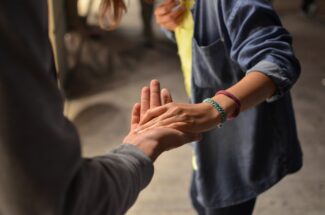 Each summer, our community service director and I run an urban plunge program for our high school students. This experience is an opportunity for students to engage with a variety of neighbors in their own local community — particularly individuals whose stories and experiences are different than their own, and particularly with groups who are often marginalized. This summer, we took them to four different communities around the Dallas area to have dinner and engage in fellowship. They were invited to listen to the stories and experiences of these communities and practice empathy as they learned more about their neighbors.
Each summer, our community service director and I run an urban plunge program for our high school students. This experience is an opportunity for students to engage with a variety of neighbors in their own local community — particularly individuals whose stories and experiences are different than their own, and particularly with groups who are often marginalized. This summer, we took them to four different communities around the Dallas area to have dinner and engage in fellowship. They were invited to listen to the stories and experiences of these communities and practice empathy as they learned more about their neighbors.
Of all the times we’ve done this program, this year there were so many more tangible moments of community, fellowship, and friendship. They dined and spoke with people who had experienced homelessness, people living with HIV, elderly people who had lived through the Great Depression, and young families experiencing economic challenges. At the end of each encounter, our students remarked that in those moments of fellowship and food, they felt a profound connection to people who had been strangers just a few hours earlier. It was clear that our students had made beautiful — and largely unexpected — connections with the people they met. At one location, one of our students talked at length with another teenager whose family had previously experienced homelessness. They connected through their love of sports, and left promising to keep in touch through social media after the program.
RELATED: How to Be the Eyes, Hands, and Feet of Christ
The urban plunge experience raised a lot of questions in the students’ minds. They wondered how these organizations are able to care for these individuals. They were curious about the staff who showed up daily to love and care for the people. They wrestled with how these organizations were able to effectively pay their staff or finance improvements on their structures. Struck by the friendships they had made, they cared for and genuinely worried about their new friends.
When I reflect on last summer, I’m moved by how many of these real, face-to-face encounters my students experienced — far more than I had when I was their age. And I know it will make an impact on how they choose to give of their time and treasure when they are adults. It also makes me wonder how often I forget to put a face to the organizations I support and what it would look like if I did. The students I work with already know that encountering people is not only about providing for their immediate needs, but also considering the whole person — the rich, complicated, and beautiful stories that make up the fabric of who they are.
But do I know that? Like when I consider donating to an organization that helps people living with HIV/AIDs, do I think of the two men I sat with one day at a kitchen that serves food to such individuals? Or do I think of Miguel, a man experiencing homelessness who I met many years ago, and how he selflessly offered to pray for me and my family, when I consider giving to a homeless shelter? Or do I picture a young boy experiencing hearing loss, like my son, whose family can’t afford hearing aids when I consider giving to a foundation that supplies hearing aids for children in need? Or do I sometimes fail to see those faces in front of me when I let an opportunity to give pass me by?
RELATED: 4 Things You Need to Know About #GivingTuesday
Most of the locations we visited during Urban Plunge are supported in part by a day in early September called North Texas Giving Day. During this day, these communities hope to receive generous donations to continue the life-giving work they do. Last year, AIDS Services of Dallas, one of the locations we visited during our Urban Plunge, raised $7,598 which exceeded their goal of $5,000. And, the St. Vincent de Paul Society, through which we met and played games with such wonderful families, was able to meet their goal of $50,000 which will help them continue to offer direct aid in terms of financial, material, and emotional support to those in need across nine counties in Texas.
As we approach #GivingTuesday, it’s a reminder of just how life-changing giving days like this can be. Experiencing encounters alongside my students reminds me of the importance of monetary giving, an importance I can so often forget. In my own heart, I have always focused on giving what I can, to both my parish and my school, because I’ve seen how they inspire incredible young students that give so much of themselves. However, the question I still need to ask myself is: Am I really giving what I can? I hope to be able to better answer that question moving forward. This year, as you consider giving on #GivingTuesday, I invite you to think about the faces of those you will help with each donation — consider the intricate fabric of their stories and lives — imagine that each person you support will be better able to be the hands and feet of Christ in the world. And then, donate and help organizations meet their goals!